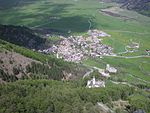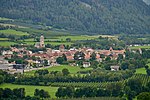St. Benedikt (Mals)

St. Benedikt is a pre-Romanesque church in Mals, South Tyrol, known for its Carolingian-era frescoes. It was built in the second half of the 8th century. Until the 12th century, it was owned by the bishops of Chur. In the 12th century, the romanesque tower was added. In the 18th century, under Joseph II, the building was used for storage. Use as a sacral building was resumed only in the 20th century, after the discovery of the Carolingian frescoes. The frescoes are dated to c. AD 800. They belong to a limited set of surviving frescoes of the Carolingian period, alongside those of the nearby St. Johann abbey in Val Müstair, Grisons. The frescoes are mostly distributed in three niches in the altar wall, showing Jesus Christ in the center, flanked by pope Gregory the Great and Saint Stephen. On the walls separating the niches are donor portraits below a troop of twelve angels, and scenes showing Gregory writing his Dialogi and disputing with Paulus Diaconus, alongsides scenes showing Paul of Tarsus and a fragment of a scene from the life of Saint Benedict.
Excerpt from the Wikipedia article St. Benedikt (Mals) (License: CC BY-SA 3.0, Authors, Images).St. Benedikt (Mals)
Kreuzweg - Via della Croce, Vinschgau - Val Venosta
Geographical coordinates (GPS) Address External links Nearby Places Show on map
Geographical coordinates (GPS)
| Latitude | Longitude |
|---|---|
| N 46.6903 ° | E 10.5395 ° |
Address
St. Benedikt - San Benedetto
Kreuzweg - Via della Croce
39024 Vinschgau - Val Venosta
Trentino-Alto Adige/Südtirol, Italy
Open on Google Maps








